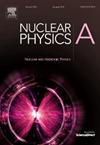100Ru中可能的反磁旋转研究
IF 1.7
4区 物理与天体物理
Q2 PHYSICS, NUCLEAR
引用次数: 0
摘要
在半经典粒子转子模型(SCM)的基础上,研究了100Ru中反磁旋转的可能性。在高自旋18+ ~ 28+范围内,动态惯性矩(2)落在典型的反磁旋转范围内。计算得到的跃迁概率B(E2)值随自旋的增加而减小,观测到的λ(2)值与计算得到的B(E2)值随自旋的增加而急剧增加,表明可能具有反磁自转特性。此外,计算得到的构型π(g9/2)−2⊗ν[h11/22(g7/2)2]的自旋(η)与频率(MeV)关系图与实验值相当,支持了在100Ru的正宇称带存在AMR现象的可能性。本文章由计算机程序翻译,如有差异,请以英文原文为准。
Study of possible antimagnetic rotation in 100Ru
The study of possibility of antimagnetic rotation in 100Ru is studied on the basis of semiclassical particle-rotor model (SCM). In the high spin range 18+ to 28+, the dynamic moment of inertia falls within the typical range of antimagnetic rotation. The decrease in calculated transition probability B(E2) values with an increase in spin, and a sharp increase in the ratio of observed and calculated B(E2) values with spin shows the possible antimagnetic rotation character. Additionally, the calculated spin (ħ) versus frequency (MeV) plot of configuration ⊗ , which is comparable with experimental values supports the possibility of the AMR phenomenon in the positive parity band of 100Ru.
求助全文
通过发布文献求助,成功后即可免费获取论文全文。
去求助
来源期刊

Nuclear Physics A
物理-物理:核物理
CiteScore
3.60
自引率
7.10%
发文量
113
审稿时长
61 days
期刊介绍:
Nuclear Physics A focuses on the domain of nuclear and hadronic physics and includes the following subsections: Nuclear Structure and Dynamics; Intermediate and High Energy Heavy Ion Physics; Hadronic Physics; Electromagnetic and Weak Interactions; Nuclear Astrophysics. The emphasis is on original research papers. A number of carefully selected and reviewed conference proceedings are published as an integral part of the journal.
 求助内容:
求助内容: 应助结果提醒方式:
应助结果提醒方式:


